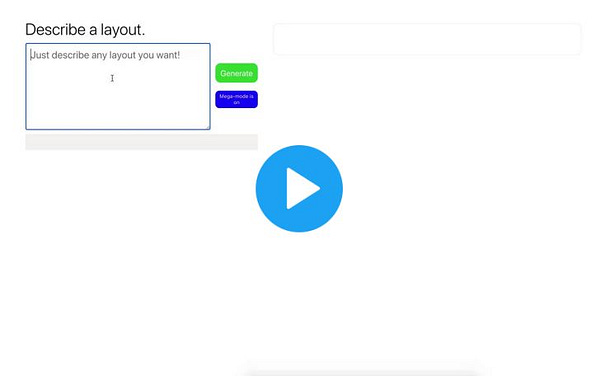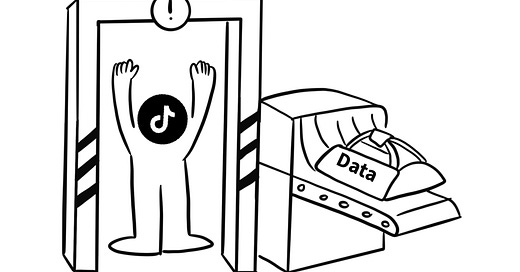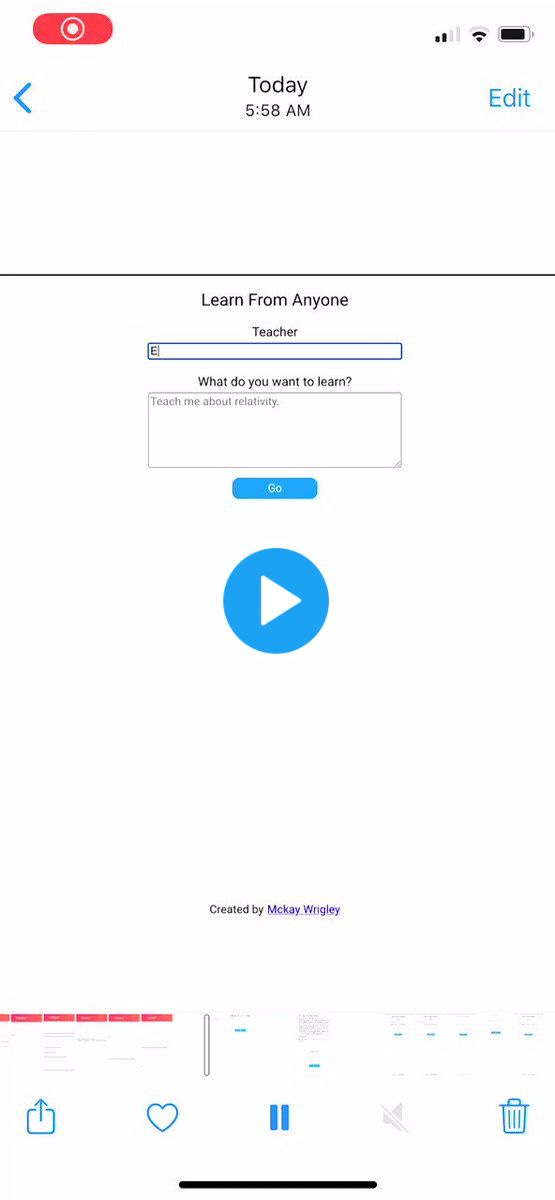Should TikTok be banned and GPT-3, hype or hope?
TikTok faces challenges on all fronts, is it warranted or simply xenophobia? And we discuss the hottest tech product this week, OpenAI’s API for GPT-3 and what it means for the future.
Hey friends 👋🏽
From Twitter hacks to TikTok bans, it has been busy week for the news ferry. In case you didn’t notice, i’m experimenting with a new name for the weekly newsletter so feel free to let me know your thoughts and name suggestions!
If you want to connect to suggest stories, ask me a question or to share with me your disagreements, hit me up on Twitter. Don’t forget to join a bunch of other smart and curious folk and get this newsletter in your inbox every week:
Lets get into it.
US Gov’t + Instagram to TikTok: A nice user base you’ve got there, would be a shame if something happened to it.
TikTok is facing a fight for its survival. The popular video app is taking fire from all directions and is scrambling to put together a response.
India banned TikTok along with 59 other Chinese apps citing national security risks.
The Trump administration is considering banning Chinese apps like TikTok over concerns they could be used for surveillance by the Chinese Communist Party.
The Committee on Foreign Investment in the United States has opened an investigation whether Bytedance’s purchase of Musical.ly has the potential to provide the Chinese government access to a large pool of American information.
The Pentagon has ordered all military personnel to delete TikTok citing security concerns.
Wells Fargo has instructed all its employees to remove TikTok from any corporate owned devices.
While no concrete moves have been made yet by the U.S gov’t, the uncertainty may be all its competitors needed to wean away TikTok’s huge audience.
There are tens of thousands of American TikTok stars who make their living on the platform and are now unsure if their revenue stream will remain in the US. This lack of certainty provides a huge incentive for many of these stars to start mitigating the platform risk and start building up / move their audience to a different platform.
Reels: Instagram, the social media juggernaut announced that it would be introducing a new feature in its app called Reels. Put simply, its TikTok wrapped in an Instagram package. The feature would come with everything you’ve come to know and love TikTok for. You’ll be able to adjust your video speed, add a countdown timer and borrow audio from another user’s video among other things. Its the clearest sign from the social media behemoth that is is coming for TikTok’s lunch. They successfully adopted SnapChat’s ‘stories’ and practically doomed them to a being a niche player. I’m sure Instagram hopes this move will have the same effect on TikTok.
Instagram isn’t the only player hoping to capitalise on TikTok’s position. Snap is already testing changes to its user interface and gestures to make it more similar to TikTok:
Alphabet subsidiary, Youtube, and Vine (the OG) reincarnated as Byte has also been trying to get in on the party.
Off all the available platforms, Instagram would probably provide the most seamless transition for TikTok users. Its new features would give it similar functionality to TikTok. The app also has the largest user base and most of these TikTok users already have existing accounts and followers on Instagram.
Are there any actual cybersecurity risks with TikTok? While the US government and India have voiced concerns regarding TikTok + other Chinese apps collecting data illegally and sharing this information with foreign governments (mainly the Chinese Communist Party), there has been scant evidence of any such behaviour. Cybersecurity vulnerabilities (e.g SMS spoofing vulnerability highlighted in Jan) have been previously identified and quickly resolved by the company. These kinds of security risks however, are not specific to TikTok or related to any government but likely just some of the growing pains a company goes through.
TikTok readies its defences:
The company has already assembled an army of lobbyists in Washington to face the battle on the political front.
Bytedance is also doing its utmost best to assure the U.S government that TikTok is a US application with a separate Chinese app called Douyin.
The company states that its user data is stored in Virginia, with a backup only in Singapore.
TikTok pulled its operations out of Hong Kong after new national security laws were imposed bringing with it Chinese-style censorship.
The company recently appointed former Disney Head of Streaming, Kevin Mayer as its CEO and has hundreds of employees across safety, security, product and public policy in the U.S.
Political advertising is banned on the platform
Read the company’s statement here.
What to consider: From all the available evidence, it seems that the concern with TikTok mainly stems for the “potential” of data collection of US/Indian citizens and its abuse by the CCP. This is a legitimate concern since any company operating in China has to comply with the demands of the party. The Chinese government also has a history of gaining control over nodes in informations systems and not using it immediately. Instead, holding on to it until an opportune moment. However, without any hard evidence of such behaviour, these accusations and actions reek of xenophobia.
If the U.S and India want to ban TikTok to protect their local apps or to stifle the platform’s growth, they should just be upfront about their intensions. The CCP would be in no position to complain. It would just be noisy hypocrisy considering how China has blocked all potential foreign competitors from entering its markets to nurture its local tech giants.
Big Picture: Since 2009, China has banned U.S platforms like Facebook (and Instagram) from its shores. This means that today, if there was to be a single app that would be used globally, it would have to be a Chinese app. While Facebook and Instagram may dominate the rest of the world, those apps aren’t available in the Chinese market and hence cannot be a truly global service. Looking at the exponential growth rate and widespread adoption of TikTok, it is likely that it was on its way to be the first dominant and truly global social media service. These moves by the Indian and U.S government will make sure that it will not happen.
Dominoes: These actions will likely result in the strengthening of Instagram/Facebook’s hold on the social media space. We will also probably see the rise of the first Indian social media giant as former TikTok stars and users flocked to previously ignored Indian equivalents like Roposo and Chingari.
GPT-3 to Human: “I’m ready to talk”
Last week, OpenAI started giving access to its API to select members of the public.
Who is OpenAI? Founded in 2015, it is a “capped” profit artificial intelligence research company co-founded and funded by star studded cast including Sam Altman (now the CEO) and Elon Musk (who has parted ways with the company citing disagreements with its direction). While the company’s public goal is to build safe and beneficial Artificial General Intelligence (AGI) and ensuring it benefits ALL of humanity, it has faced business pressures that has forced it to take actions than can be perceived as compromising on their principles. You can read all about it in this in-depth piece here .
This API follows the non-profit releasing its paper on GPT-3, the most powerful language model ever built, in May. To put this in context, GPT-2, which was released in stages in March 2019 was already capable of producing synthetic text samples that were almost as convincing as real articles from the New York Times. All you had to do was just feed it a fake headline. This current version of the model has 175 billion parameters, about 115x larger than its predecessor. And language generating AI’s, size does matter.
How does it work? In the simplest terms, language generation models like those developed by OpenAI generate text by taking texts that you have input as a prompt and predicts the next bunch of text until it hits a specified length. The model then takes the previous text and the new texts and makes another prediction and the process keeps going until the model is instructed to stop generating. You can also tailor the temperature of the model which can affect how accurate vs how “creative” it can be.
With GPT-3, everyone uses the same model with only one function, the input of text a.k.a “priming” after which the model will predict the next several words a.k.a “tokens”.
Tech Twitter has been flooded with GPT-3 demos. People with access have been sharing all the things they could do with GPT-3. In fact, this informative article about GPT-3, 100% written by GPT-3 could probably explain the significance of better than I ever could. The model can generate any kinds of text, including music lyrics, guitar tabs and computer code. Web developer Sharif Shammeem primed the model to produce HTML instead of human natural language. He shows how you can make an entire web page layout just by describing what you would like to see on the screen:


Tone it down: Despite all the fanfare the model has been receiving on social media, even it’s CEO acknowledged that the hype was way too much.
The GPT-3 hype is way too much. It’s impressive (thanks for the nice compliments!) but it still has serious weaknesses and sometimes makes very silly mistakes. AI is going to change the world, but GPT-3 is just a very early glimpse. We have a lot still to figure out.
-Sam Altman
Dominoes: While the demos may capture all the hype, what’s amazing about the work OpenAI has done with GPT-3 is to show a type of future where we no longer have to train/construct multiple large training sets for models with different uses. We can use the same large/general model for different purposes by simply create a few relevant examples (priming) from which the models can perform a “few-shot” extrapolation.
Don’t forget to join a bunch of other smart and curious folk and get posts like these in your inbox:
More Examples:
(it is important to note that the demos you see are subject to selection bias toward good examples.)
This example is one you can actually try. This bot will take in your input and use it to produce short potential tweets based on your prompts. First, copy the url (https://thoughts.sushant-kumar.com/input1%20input2) into your browser address bar. Secondly, replace the terms input1 and input2 with your own inputs. Note that the “%20” represents the whitespace. So if you wanted to type in the word “Hong Kong”, your url should look like this: https://thoughts.sushant-kumar.com/hong%20kong
(note: the accuracy and usability of the result varies greatly)You input who you want to learn from and what you want to learn. The model will return you the knowledge from that person:
You input your description for your app and model will write out the React code for your app in seconds.
This is an entire tweet thread about “running a startup” generated by GPT-3 using the user’s past tweets as prompts:
This example shows how GPT-3 is able to summarise a complex passage. The summary is the red section:











